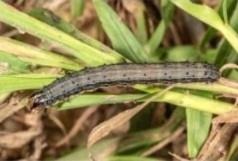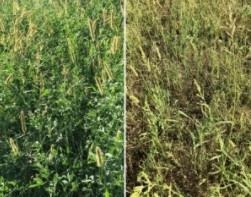By Victor Shelton
It has been another odd year with the weather. Some areas that were extremely dry early in the year are now enjoying abundant forages and rapid regrowth. Some areas that were wetter than normal during that same period are now on the dry side. No matter where you are located, you should always be prepared for changes in weather conditions and have some type of contingency plan in place. You buy insurance for those “just in case” circumstances, you need to do the same with forages.

Be on watch for fall armyworms!
I’m not saying you need to go and buy insurance for your forage base, but you should have some kind of contingency plan in place for any odd circumstances that might befall upon you. For most people, that is stored forage, e.g., hay, balage. It could also be stockpiled forage, annuals or crop residue as we go into the fall season.
It is not just weather you need to plan for either. You have probably already read that there have been problems with fall armyworms in some locations. As adult worms these masticating menaces can cause an enormous loss of forage/pasture in a very short time frame if numbers are high enough. What is that threshold? Most note two to three adult worms per square foot as enough to initiate some type of action.
By the time you see real damage and a threshold of more than two full size worms per square foot, they are a lot harder to control chemically. Scouting ahead and checking fields on a regular basis can allow more options for treatment, and chemicals may be needed. Organic producers and producers concerned about use of insecticides on pastures being utilized have limited option of what can be done besides spraying.
My first knee jerk reaction on a pasture or hay site — especially when you are relying on that forage for grazing or winter feed — is to mechanically harvest it, mow it, ASAP and then dry, rake and bale it as quickly as possible too. For a bit more impact besides just saving/salvaging some future feed, using a mower conditioner at a time of day with more fall armyworm activity “might” help to reduce the population a little. Tighten down those rollers! Fall armyworm activity is higher under the cooler conditions of morning or early evening.

Before and after damage of fall armyworms in SE Indiana.
But, before you just start cutting everything for hay, which will have its own consequences, make sure it is absolutely necessary and unavoidable because it could greatly reduce any potential grazing days for the remainder of the year. Mechanically removing those forages, plus reduced leaf matter from the fall armyworms, will slow regrowth tremendously and the plants may need the majority, if not all, of that regrowth to rebound for the next growing season.
Graze livestock where damage has not occurred badly yet. If you are hit hard by damage, treat the affected fields like a field that has been overgrazed or under droughty conditions. Provide adequate rest, clip if needed to recycle remnants and feed hay until there is sufficient regrowth to graze again.
If you scout and find them early enough to successfully use an insecticide, make sure to follow all label instructions and grazing/harvesting restrictions and consult with your local extension office. If all pasture acres must be treated, then contain livestock in a dry lot and feed accordingly until safe to return and sufficient regrowth is present.
Some livestock tend to not appreciate the leftovers of fall armyworms. They may also snub hay that was harvested containing very many worm carcasses. This may increase hay waste during feeding some and warrant feeding some of this hay back out on the field that it came from in order to return some of the nutrients to the site. Unrolling hay would be the ideal method of feeding this to get the best nutrient distribution from both wasted hay and manure. In some situations, the affected hay could be mixed with better hay in a total mixed ration to improve intake by dilution.
I suppose that if you also happen to have some poultry on pasture, that there could be something a bit positive from the whole situation, especially if the worms don’t get too bad – some cheap high protein chicken feed!
Enough wormy famine like talk. We are, give or take, 45-60 days from the first average frost depending on where you are located. I tend to not think about it, especially when we still are having weather with the heat index in three digits, but it’s coming.
I actually put reminders on my calendar – 90 days until the first frost, 60 days, etc. Why, because it’s a reminder that I only have so many days left to plant any annuals that will be either terminated or slowed down by that first frosty morning or where sufficient growth is needed prior to that time frame. Generally, the earlier you can plant annual forage crops, the higher dry matter production potential you have. This is especially important for annuals that are usually not winter hardy such as fall planted spring oats and turnips. The earlier planted, the more to utilize that fall. Those reminders also help me to remember to get fall garden items planted in a timely manner so fresh delectables for the dinner table can continue.
Quite a bit of the area has been blessed with enough moisture that forages have continued to grow well and that has certainly increased the ability or likelihood of stockpiling some forage for use later this winter. The percent legume in the sward and what legume(s) are present will be a good indicator of how much nitrogen might be beneficial to be applied to your stockpiled forage to boost yield and quality. The newer white clovers can produce unbelievable amounts of nitrogen, sometimes up to ~150 pounds or more during a season once established.
When clover percentage of the sward is 30 percent or higher, you may not need to apply much or any additional nitrogen to the stockpiled forage. When clover makes up about a third of the stand, nitrogen is usually not too much of a limiting factor, especially with the newer varieties.
If the percentage is 15-30 percent, then 30 to 40 units of nitrogen is beneficial and will certainly boost yields. I would consider grazing these areas a little harder, or what I would call “hammering” it, to help open up the sward to enhance the clover content the next spring once it is dormant.
If the percentage is less than 15 percent, then 40 to 70 units of nitrogen is needed to boost yields and increase feed quality. I would certainly “hammer” these areas some to thin the grass a little and then frost seed some clover into these areas sometime between Christmas and Valentine’s Day.
Be careful not to “hammer” the fields too much. You just want to set the grass back a bit, not destroy it. In some cases, overdoing it can lead to excessive amounts of clover where there is a huge seedbank or an increase in weeds. You must have a good stand of desirable grasses; too many weeds will just promote more weeds doing this.
Source : osu.edu